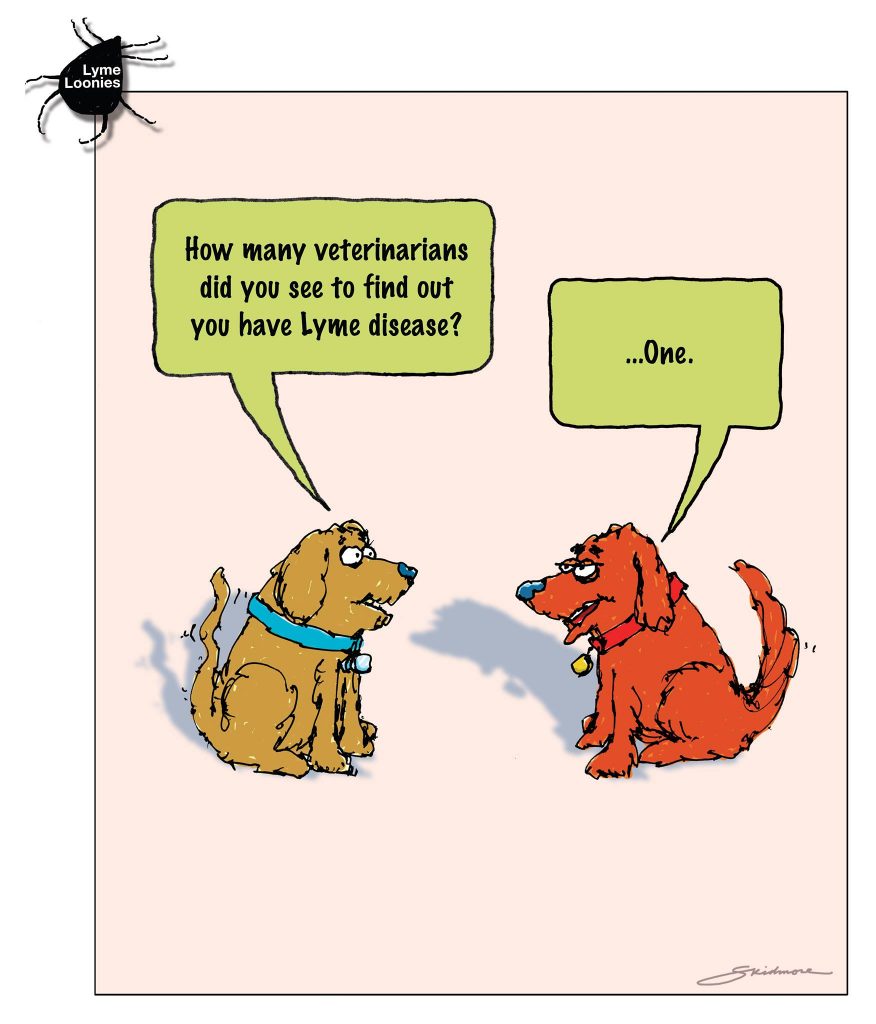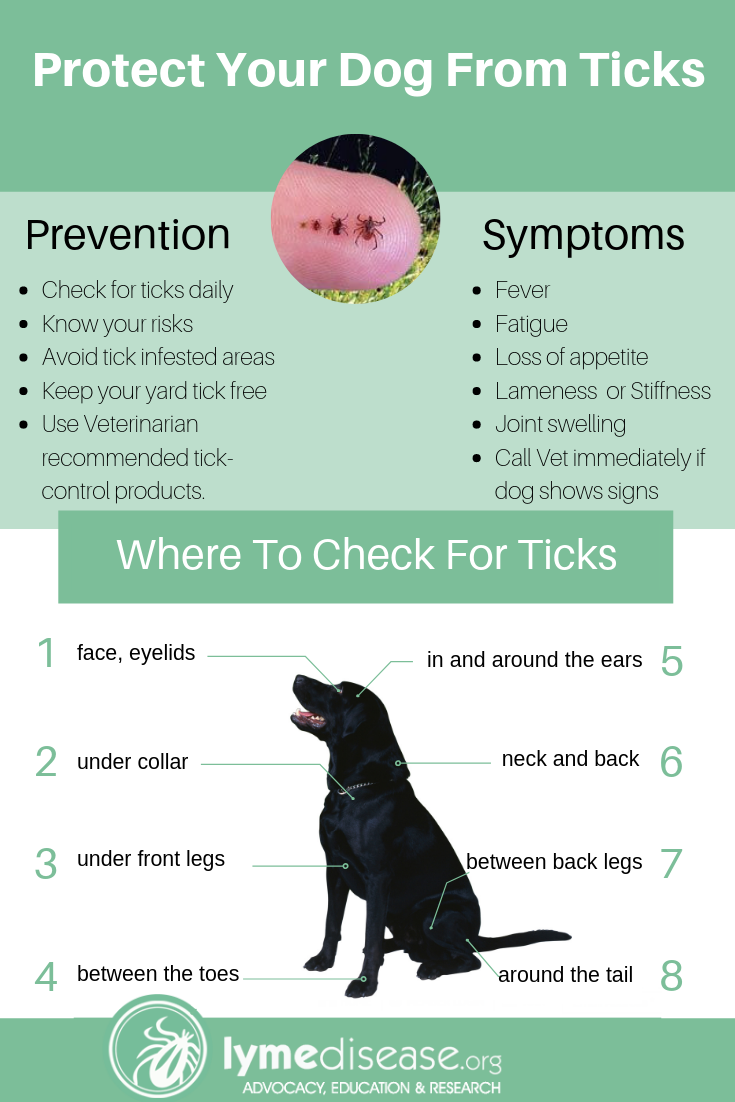LYME SCI: Found a tick on your dog? What you need to know.

As much as we love our furry friends, we all have to face one fact—owning a pet increases our exposure to tick bites. Mostly because our pets roam outside, then allow ticks to hitchhike back inside where we live.
One recent study demonstrated that when compared to households without pets, pet-owning households had nearly twice the risk of finding ticks crawling on them. [1] Yikes!
I recently took my daughter’s dog in to our veterinarian, Timothy Bell, DVM, for a well check-up. I used the opportunity to ask a few questions.
Dr. Bell’s philosophy is pretty straight forward:
- Protect your pets from ticks year-round,
- Keep your pet up-to-date on all vaccines,
- Know what types of ticks live in your area,
- Know what pathogens those ticks carry,
- Know what symptoms to watch for,
- Screen your pet annually (sooner if showing symptoms) for common infections.
My vet personally uses NexGard on his dogs. Although Dr. Bell says, “NexGard doesn’t actually protect your dog from all tick-borne diseases. The tick has to bite the dog before the active ingredients will kill the tick.” Unfortunately, as we all know, some pathogens are transmitted within just a few hours. (I address more about products and how to control ticks below.)
False sense of security?
He advises, “Don’t get a false sense of security with any flea or tick control product. You still need to watch for symptoms. If I were going hiking or camping where I knew my dog were going to be exposed to more ticks, I would use a topical spray or collar that both repels and kills ticks.”
Dr. Bell says many of the tests for tick-borne diseases are prone to false negatives, especially in the early stage of illness. For instance, with Rocky Mountain spotted fever, the dog may have a fever and get very sick. “Whether I see the tick or not, if the dog has symptoms, I give it doxycycline.”
While Lyme is the most common tick-borne disease, we also have a fair amount of tick paralysis in my part of California (the central coast). Tick paralysis is a potentially fatal disease that occurs when certain species of ticks inject neurotoxins from their salivary glands into a warm-blooded animal or human. [2]
Dr. Bell explains, “with tick paralysis, the dog will be weak, wobbly and will quickly progress to the point it can’t walk. Eventually, paralysis will affect the dog’s respiratory system, if you don’t get the tick off.” Products like NexGard offer good protection against tick paralysis.
The best part about our visit to the veterinarian was that we were in and out the door within 45 minutes. During that time, they tested our dog for multiple blood-borne pathogens and intestinal parasites. They also updated his vaccines for multiple preventable illnesses, and refilled his prescription for tick-control medication. (See here for the complete guide to the American Kennel Club recommended vaccination schedule)
Dogs as sentinels of human disease
While dogs may increase our risk of disease by bringing ticks home, a new study shows how they can also alert us to the risk for Lyme disease.
Because the CDC reporting criteria is very restrictive, many cases of human Lyme disease are not represented on the CDC maps. This has led to the incorrect perception that Lyme only exists in the Northeastern portions of the U.S.
In fact, the risk for Lyme disease is everywhere. Companion Animal Parasite Council (CAPC) is an independent council comprised of veterinarians, parasitologists and animal health care professionals. It has been studying the prevalence of Lyme and other tick-borne diseases in dogs since 2002.
CAPC’s latest research clearly “shows how man’s best friend continues to safeguard humans as a sentinel to alert humans where they are at greatest risk for Lyme disease,” said Christopher Carpenter, DVM and executive director of CAPC. “The model established in this research breaks new ground to give residents, travelers and health care providers a county-level map to help them identify areas of risk across the country.” [3]
By mapping the prevalence of Lyme disease in dogs, the researchers can predict where the risk is highest for humans. To see where your risk is highest for the three most common tick-borne diseases (Lyme disease, anaplasmosis, ehrlichiosis), visit CAPC’s interactive map here. Click on your state, zoom into your county, then use the drop-down box to scroll between the three different diseases reported over the past eight years.
Prevention is key
Because pets can’t tell us when they feel sick, the best thing to do is prevent tick bites in the first place. Like Dr. Bell said, “Even if you don’t have the highest incidence of infection in your area, when your pet gets sick, you’re going to wish you had protection.”
There is a large list of products available for dogs, but not all of them are safe for cats. Talk to your veterinarian about which product is best for your pet. We opted to go with NexGard for our dogs because my husband raises bees. Some products that are applied topically are great at repelling and killing ticks and fleas, but can be damaging to pollinators—something my household is very mindful of.
In summary
- See your veterinarian annually, talk about vaccines for preventable diseases, tick control products, and ask for an IDEXX SNAP 4Dx 4-in-1 screening for the most common vector-borne diseases.
- Know your pet’s risk for the most common tick-borne diseases by checking the CAPC website,
- If you find a tick on your pet, submit a picture to Tick Spotters. Or you can try to identify it yourself by using TickEncounter, or TickTracker.
- Contact your veterinarian immediately if your pet shows any signs of illness.
After my visit to the vet, I reached out to Thomas Mather, Ph.D University of Rhode Island’s Center for Vector-Borne Disease and director of the TickEncounter Resource Center. He’s known as “The Tick Guy.” I’ll be talking about what I learned in my next blog.
Helpful Resources:
AKC | Keep Your Dog Safe From Fleas and Ticks With These 10 Prevention Tips
Bay Area Lyme Foundation | Free Tick Testing
CDC | Preventing Ticks on Your Pets
TickEncounter.org| Protect your pets
Tick Spotters | Did you find a tick?
Tick Tracker | Report and track your tick
LymeSci is written by Lonnie Marcum, a Licensed Physical Therapist and mother of a daughter with Lyme. Follow her on Twitter: @LonnieRhea Email her at: lmarcum@lymedisease.org .
References:
- Jones EH, et al. (2018) Pet ownership increases human risk of encountering ticks. Zoonoses Public Health. Feb;65(1):74-79. DOI: 1111/zph.12369
- Haas E, et a. Tick Paralysis – Washington State, 1995. CDC | MMWR April 26, 1996 / 45(16);325-6
- Liu, Y., Nordone, S., Yabsley, M., Lund, R., McMahan, C., & Gettings, J. (2019). Quantifying the relationship between human Lyme disease and Borrelia burgdorferi exposure in domestic dogs. Geospatial Health, 14(1). https://doi.org/10.4081/gh.2019.750






















We invite you to comment on our Facebook page.
Visit LymeDisease.org Facebook Page